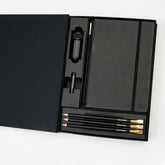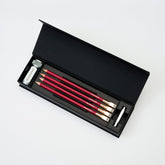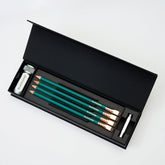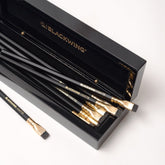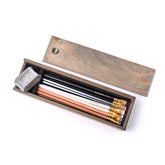The Evolution of Animation - Blackwing Vol. 7
Blackwing Volume 7, the evolution of animation
Blackwing Volume 7 celebrates the history of animation. Vol. 7’s unique design features 6 different interlaced patterns that form a 7-frame animation when seen through a viewfinder. The viewfinder uses a process known as “picket fence animation” or “barrier-grid design” which is a predecessor to film animation. This Picket-Fence animation technique and other analog animation devices laid the groundwork for animation as we know it today.

Magic Lantern Image Projector circa 1600s
One of the earliest examples of animation devices dates back to 1603. The Magic Lantern used painted glass slides that were moved through the device that were then projected onto surfaces using candlelight and a lens. When the images on the glass slides were moved at the right speed, it gave them the illusion of animation. The Magic Lantern was a popular form of entertainment in early Western Europe, it went on to serve as a tool for education and eventually appeared as children’s toys.

Thaumatrope circa early 1800s, Gif courtesy of RandomMotion.com
Greek for “wonder turner,” the Thaumatrope was a disc attached to strings that appears to show two images at once when the strings were spun between the user’s fingers. The first recorded instance of this device was in the 1827 book, Philosophy in Sport Made Science in Earnest by John Ayrton Paris. Typically the disc has related images on both sides, and through a phenomenon known as persistence of vision, the two images would merge when spun. Popular image pairs include a bird and a cage, or a tree with and without leaves. Examples of the Thaumatrope can be seen in period drama films, including the 1999 film Sleepy Hollow and 2006’s The Prestige.

Phenakistoscope circa 1833
This device was known by multiple names before the height of its popularity but is most commonly referred to as the Phenakistoscope. The technology of this device relied on a viewer peering through apertures at a series of illustrations that, when spun, created the illusion of movement. Multiple variations of this device also existed: a single disc with apertures that required the viewer to face a mirror; a double-disc device for a single viewer with apertures on one side and the illustrations opposite (pictured above); and a double-disc where both sides were illustrated with apertures and accommodated two viewers. This was considered the precursor to the Zoetrope (below), and also a more contemporary form of looped animation: the gif.

The Zoetrope followed up on the Phenakistoscope‘s popularity with a few upgrades, including a cylindrical shape that could be viewed by multiple people at once, and animation on slips of paper that could easily be interchanged. Zoetrope animation techniques(whose name means “life turning” or “wheel of life” in Greek) have been used more contemporarily in subways starting in the 1990s, and with 3D objects at different phases of motion. Zoetropes have enjoyed continued popularity through the present day, making appearances in things like Blue Man Group performances, music videos, television, films, and toys.

Booby Trap by Ben Zurawski/TheFlippestFlipBooks
Many of us can recall a time in our childhood when we owned a flip book or made our own; hours spent penciling in tiny drawings on each page and beholding the fruits of our labor with that first flip through. Flip books hold the power of animation frames right in the palm of your hand, the speed at which the pages move giving the illusion that the objects drawn within are moving too. The first recorded instance of the flip book dates back to 1868 by John Barnes Linnett, who patented the booklet as the kineograph (“moving picture”). More recently, flip books have moved into the digital age. Now, it is possible to submit sequential photos or digital pictures to print companies who will print and bind your flip books for you, saving you precious hours.

Praxinoscope in motion
From Phenakistoscope to Zoetrope to Praxinoscope, the final evolution of the cylindrical animation viewer appeared in 1877 and made a few more updates to the past iterations. The viewing slits of the Zoetrope were removed, and instead, mirrors were added to an inner cylinder which reflected the animation back to the viewer from the outer cylinder. Additionally, some models appeared with a hand crank below the cylinder, which kept the device in a continuous state of motion. If the animation above looks familiar, you might have experienced a Praxinoscope on a grander scale; some carousels have mirrors along the interior perimeter; when paired with the ride moving in a circle and the carousel horses moving up and down, the rider can witness the horses appearing to gallop fluidly while still affixed to the ride.

Picket fence animation, or barrier-grid design, pairs carefully designed interlaced images with a viewfinder. When the viewfinder moves across the pattern, the openings not only complete the picture, they can give the illusion of movement – as seen above with our Blackwing Volume 7 animation above. This technique emerged in the mid-to-late 1800s but wasn’t officially patented until 1906, by Alexander S. Spiegel. Spiegel’s technology went on to be used in postcards, toys, and more recently, in children’s books using pieces of acetate with colored stripes that move across a page.
From candles and mirrors to spinning discs and viewfinders, early devices captured our imaginations and inspired enthusiasts to invent new ways to keep us fascinated with animation. The Blackwing Volume 7 honors the long tradition of analog animation with its picket-fence viewfinder, and designs inspired by legendary animator Chuck Jones’s character.
Each set of 12 pencils comes with six different designs, and each pencil features a black ferrule, gold clip, orange eraser, and our balanced graphite.
Additional Resources
Vol. 7 Behind the Design – Picket Fence Animation Tutorial
Random Motion: Animation by Ruth Hayes




